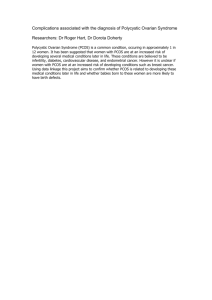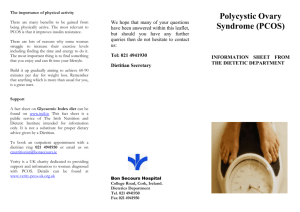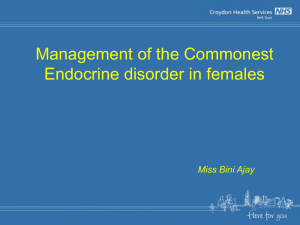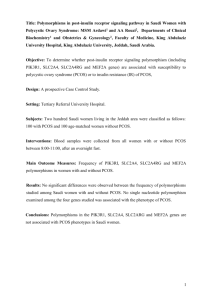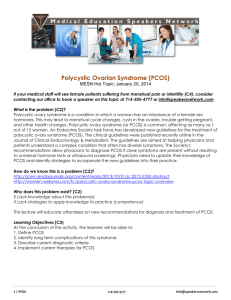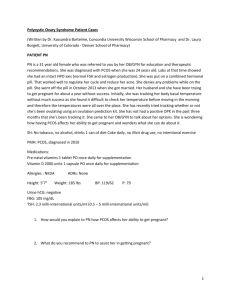Polycystic Ovarian Syndrome (PCOS)
advertisement
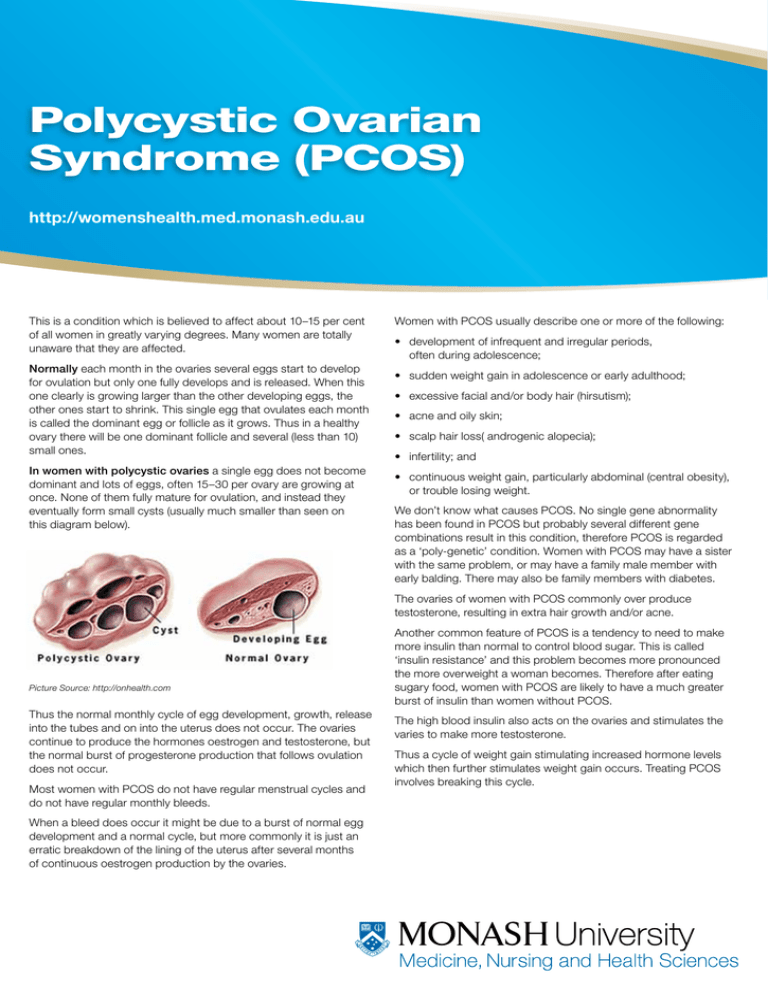
Polycystic Ovarian Syndrome (PCOS) http://womenshealth.med.monash.edu.au This is a condition which is believed to affect about 10–15 per cent of all women in greatly varying degrees. Many women are totally unaware that they are affected. Normally each month in the ovaries several eggs start to develop for ovulation but only one fully develops and is released. When this one clearly is growing larger than the other developing eggs, the other ones start to shrink. This single egg that ovulates each month is called the dominant egg or follicle as it grows. Thus in a healthy ovary there will be one dominant follicle and several (less than 10) small ones. In women with polycystic ovaries a single egg does not become dominant and lots of eggs, often 15–30 per ovary are growing at once. None of them fully mature for ovulation, and instead they eventually form small cysts (usually much smaller than seen on this diagram below). Women with PCOS usually describe one or more of the following: • development of infrequent and irregular periods, often during adolescence; • sudden weight gain in adolescence or early adulthood; • excessive facial and/or body hair (hirsutism); • acne and oily skin; • scalp hair loss( androgenic alopecia); • infertility; and • continuous weight gain, particularly abdominal (central obesity), or trouble losing weight. We don’t know what causes PCOS. No single gene abnormality has been found in PCOS but probably several different gene combinations result in this condition, therefore PCOS is regarded as a ‘poly-genetic’ condition. Women with PCOS may have a sister with the same problem, or may have a family male member with early balding. There may also be family members with diabetes. The ovaries of women with PCOS commonly over produce testosterone, resulting in extra hair growth and/or acne. Picture Source: http://onhealth.com Thus the normal monthly cycle of egg development, growth, release into the tubes and on into the uterus does not occur. The ovaries continue to produce the hormones oestrogen and testosterone, but the normal burst of progesterone production that follows ovulation does not occur. Most women with PCOS do not have regular menstrual cycles and do not have regular monthly bleeds. When a bleed does occur it might be due to a burst of normal egg development and a normal cycle, but more commonly it is just an erratic breakdown of the lining of the uterus after several months of continuous oestrogen production by the ovaries. Another common feature of PCOS is a tendency to need to make more insulin than normal to control blood sugar. This is called ‘insulin resistance’ and this problem becomes more pronounced the more overweight a woman becomes. Therefore after eating sugary food, women with PCOS are likely to have a much greater burst of insulin than women without PCOS. The high blood insulin also acts on the ovaries and stimulates the varies to make more testosterone. Thus a cycle of weight gain stimulating increased hormone levels which then further stimulates weight gain occurs. Treating PCOS involves breaking this cycle. Hunger and sugar food Big insulin burst Chemicals released From fat cells Increased weight gain especially around middle ABDOMEN Increased testosterone from ovaries Tests Blood tests: these may all be completely normal or a woman with PCOS may be found to have: • high blood insulin when fasting or after a sugar challenge (oral glucose tolerance test); • high levels of testosterone or DHEAS (a hormone made by the adrenal glands, that can be converted to testosterone); and • a low level of the protein that binds to the sex hormones in the blood called sex hormone binding globulin or SHBG. Often women with PCOS have normal testosterone levels but because this SHBG protein that normally binds testosterone and holds it in the circulation is so low, more testosterone is ‘free’ and can escape into the tissues causing unwanted male – like hormone effects. Ultrasound test An ultrasound study can be performed to see the size and appearance of your ovaries. The typical appearance of an ovary affected by PCOS is lots of small cysts mostly towards the outside of the ovaries. More than 15 cysts (follicles) per ovary is considered typical of PCOS. Treatment of PCOS PCOS affects women in different ways, therefore treatment is directed towards managing the main effects of PCOS and concerns of each woman. Weight management is a common problem and this needs to be primarily addressed by diet and exercise, although medication may sometimes help. Women should avoid sugary foods to reduce stimulating big bursts of insulin release. One way of approaching this is trying to eat foods described as having a ‘low glycemic index’. This means foods that do not stimulate a big insulin surge. Examples of a high glycemic index (GI) food are sugar, dried fruit, grapes etc ie sugary foods. Examples of low GI food are fish, vegetables and multigrain bread. There are a number of books easily available that list which foods have low and high GIs. Eating low GI foods should stem hunger and help with weight management. Avoiding processed foods that are high in fructose may also be useful. Consumption of large amounts of fructose has been linked to fatty liver, insulin resistance and elevated blood pressure. Women with PCOS who have a high fasting blood insulin, and/or an abnormally high insulin surge after a sugar challenge (oral glucose tolerance test – OGTT) often respond well to treatment with a medication called metformin. Metformin increases the sensitivity of the body to insulin, so less insulin needs to be made, and the abnormal cycle is interrupted. Treatment with metformin is associated with return of regular menstrual cycles and regular ovulation, and sometimes weight loss as well. This treatment is often used for women with PCOS trying to get pregnant. Metformin may cause diarrhoea, so it is generally started at a low dose, with a gradual increase in dose. Women with PCOS who are troubled by acne and excess hair growth may respond to treatment with a class of drugs called anti androgens. These include cyproterone acetate (Androcur) and spironolactone (Aldactone.) Aldactone was originally used to treat blood pressure and heart failure but was found also to be effective for treatment of testosterone excess. It works by blocking testosterone action. It may result in normal periods in women with irregular periods, but in women with regular periods it may cause erratic bleeding. It can be used in combination with the oral contraceptive pill. Aldactone is not a hormone. Androcur is a synthetic hormone which blocks androgen action and also acts like progesterone, so it can be combined with oestrogen in the oral contraceptive pill. It is also prescribed at higher dose for the treatment of excess body hair, acne and scalp hair loss (androgenic alopecia). It is usually well tolerated, but may cause drowsiness or irritability in some women. Some women find that the oral contraceptive pills that contain androcur or drospirenone effective treatment for acne and hair growth. Excessive hair growth can also be managed cosmetically by plucking, bleaching, waxing, electrolysis and laser therapy. No treatment for excess hair has been shown to be permanent. Long term effects There is no cure for PCOS but for women who are overweight the best care is weight control, and ideally weight loss. Women with PCOS who are overweight have a greatly increased risk of developing diabetes after the age of 40 years. Although it is said that women with PCOS are at increased risk of heart disease, this has not been shown to be the case in women without insulin resistance or diabetes. Women who have PCOS and don’t have regular periods over several years are at increased risk of uterine cancer. Therefore we recommend treatment to create a regular bleeding cycle. The information in this flyer was correct at the time of publication. Monash University reserves the right to alter this information should the need arise. Produced by the Women’s Health Program, Monash University © – August 2010. CRICOS provider: Monash University 00008C TSG278097
